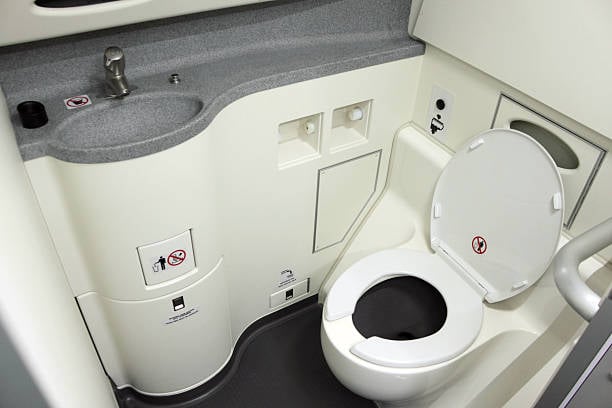There is little doubt in most people’s minds that airplane toilets are not like other toilets. You’re not alone in wondering how airplane toilets work. Most people are interested in this, and for a good reason. But did you ever wonder why your poop doesn’t stick on the airplane toilet?
Teflon coating is used on airplane toilets to prevent poop from sticking when vacuumed down the bathroom. There is very little water used.
The Early Days of Toilets in the Aircraft
Before the mid-1970s, passengers did their business in a slosh bucket or bottle that was never flushed and simply sat in the toilet until the plane landed. Around 1975, a man named James Kemper invented the airplane toilet that we know today, and it was first used in a Boeing plane in 1982.
Today’s airplane toilet bowls are nonstick and contain a small amount of water as well as a blue liquid called Skykem, which is made with the same main ingredient as “blue ice.” This liquid is used to disinfect the bowl and kill any odors lurking in the bathroom. When you flush a toilet on an airplane, the loud noise you hear is caused by the sucking or vacuum system, not by the waste materials being thrown into the air.
The trucks use special hoses that suction waste from the plane and the plane’s tanks are always cleaned and disinfected afterward. Pilots need to clear the toilet tanks during flights, and they are also unable to do so. Not only that, but it is also illegal. (Source: Aero Corner)
Does Human Poop Fall from Planes?
Although extremely rare, there have been credible reports of large sections of blue ice landing on people’s decks and homes. Skykem and human waste have been combined to create this “blue ice.” Once the plane reaches high altitudes, it freezes and leaks out of the undercarriage. It dislodges as the plane approaches landing because the temperature rises at this point.
Again, this is an infrequent occurrence, so the average person does not need to be concerned about human waste falling from airplanes on their home or patio. It simply needs to happen more frequently to warrant concern. (Source: Aero Corner)
The Future of In-Flight Lavatories
The future holds even better models when it comes to airplane toilets. After all, it’s been 30 years since the last truly great invention, so the world is ready for something better. Boeing created a prototype of a new type of airplane toilet in 2016. It provides a larger kind of airplane toilet as well as a way to clean itself after each use.
When it comes to airplane toilets, the future is promising. After all, it’s been 30 years since the last great invention, so the world is primed for something better. Boeing created a prototype for a new type of airplane toilet in 2016. It provides a larger type of airplane toilet as well as the ability to clean itself after each use.
Boeing is also developing several hands-free options for airplane bathrooms, including using soap and faucet, placing something in the trash can, and even locking the door once inside. These will make airplane restrooms much easier to use, cleaner, more sanitary, and safer.
You won’t have to deny yourself when you’re in the air and nature calls because the restroom will no longer be a place you dread or fear. (Source: Aero Corner)

Selten so ein Blödsinn gelesen. Hier hat jemand sein Halbwissen vewendet.
Flugzeugtoiletten habn ein Saugsystem; bei jeder spülung wir der Inhalt des Toilettenbeckens per Unterdruck abgesaugt und in einem Zentraltank befördert, die nur am Boden von ausserhalb entleert werden kann. Am Boden oder in niedrigen Flughöhen wird dafür eine Unterdruckpumpe verwendet, ab einer bestimmten Flughöhe übernimmt es diese Aufgabe der Druckunterschied zwischen der Atmosphäre und Kabinenhöhe, die im normalen Reiseflughöhen sich bei circa 2000-2500 Metern einreguliert. Es werden auch keinerlei Chemikalien verwendet, der Toilettenschüssel wird mit einer kleinen Menge klarem Wassers aus dem Trinkwassertank des Flugzeugs gespült. Piloten haben mit dem System nichts zu tun, ausser elektrischen Systemsicherungen die im Cockpit befinden; die sich bei elektrischen Störungen aktivieren, wie bei allen Sicherungen bei der Elektrik sonst auch.
Früher wurden geschlossene Anlagen benutzt, ergo wurde vor dem Abflug eine bestimmte Menge Wasser (dann eben wegen Geruchsentwicklung mit Chemikalien versehen) in den Behälter, der sich unter jedem Toilettenschüssel befand, eingefüllt. Bei jeder Spülung wurde mittels einer Pumpe diese Flüssigkeit als Spülung verwendet. Mit der Dauer der Reise wurde diese Flüssigkeit immer mehr mit Urin, Papier und Kot vermischt und quasi recycelt und immer wieder als Spülflüssigkeit verwendet. Nach der Landung wurde dann jede einzelne Toilette von aussen entleert und erneut mit Wasser/Chemikaliengemisch aufgefüllt. Diese Systeme sind seit der 80er Jahren allmählich vollständig durch Absaugetoiletten abgelöst worden.